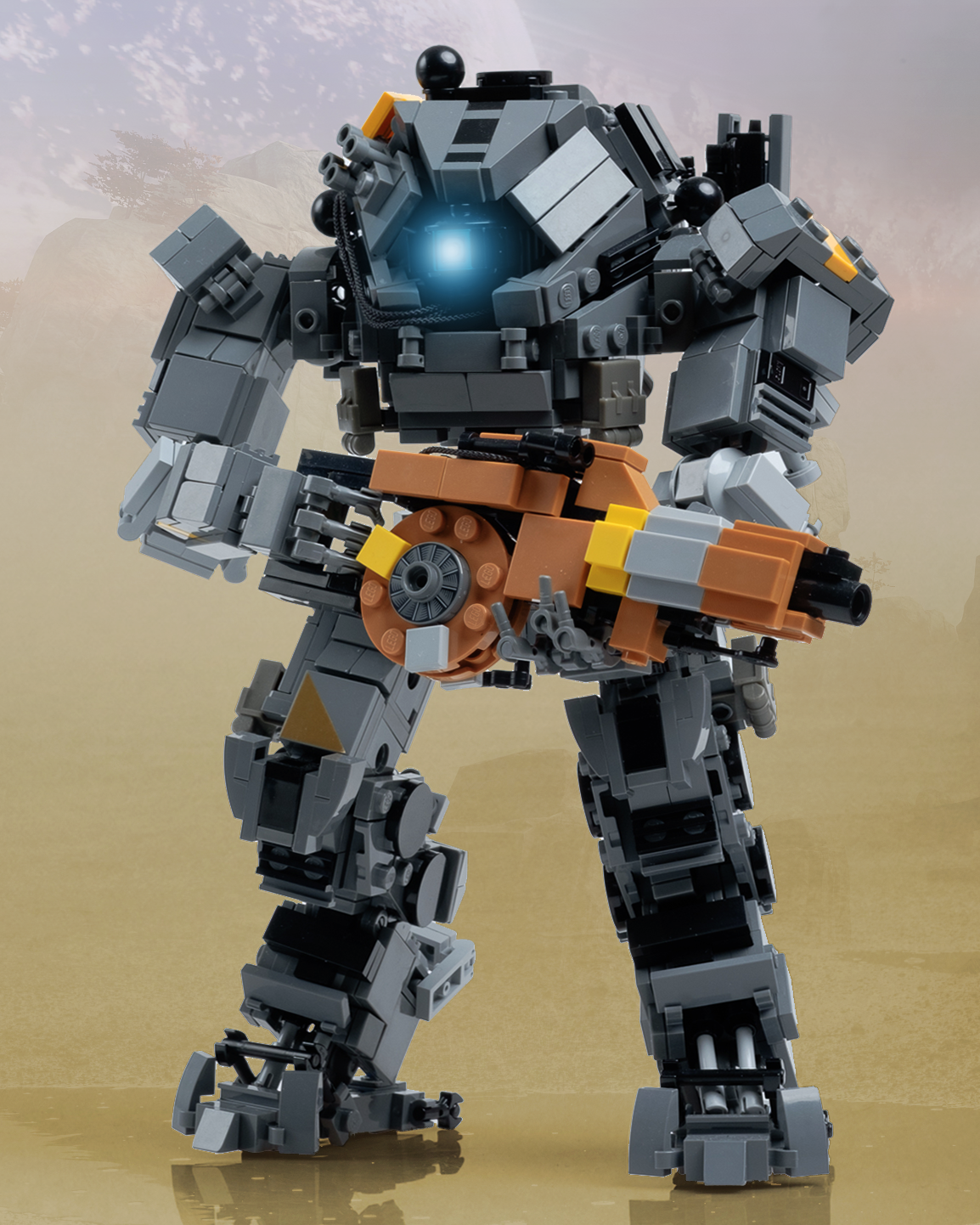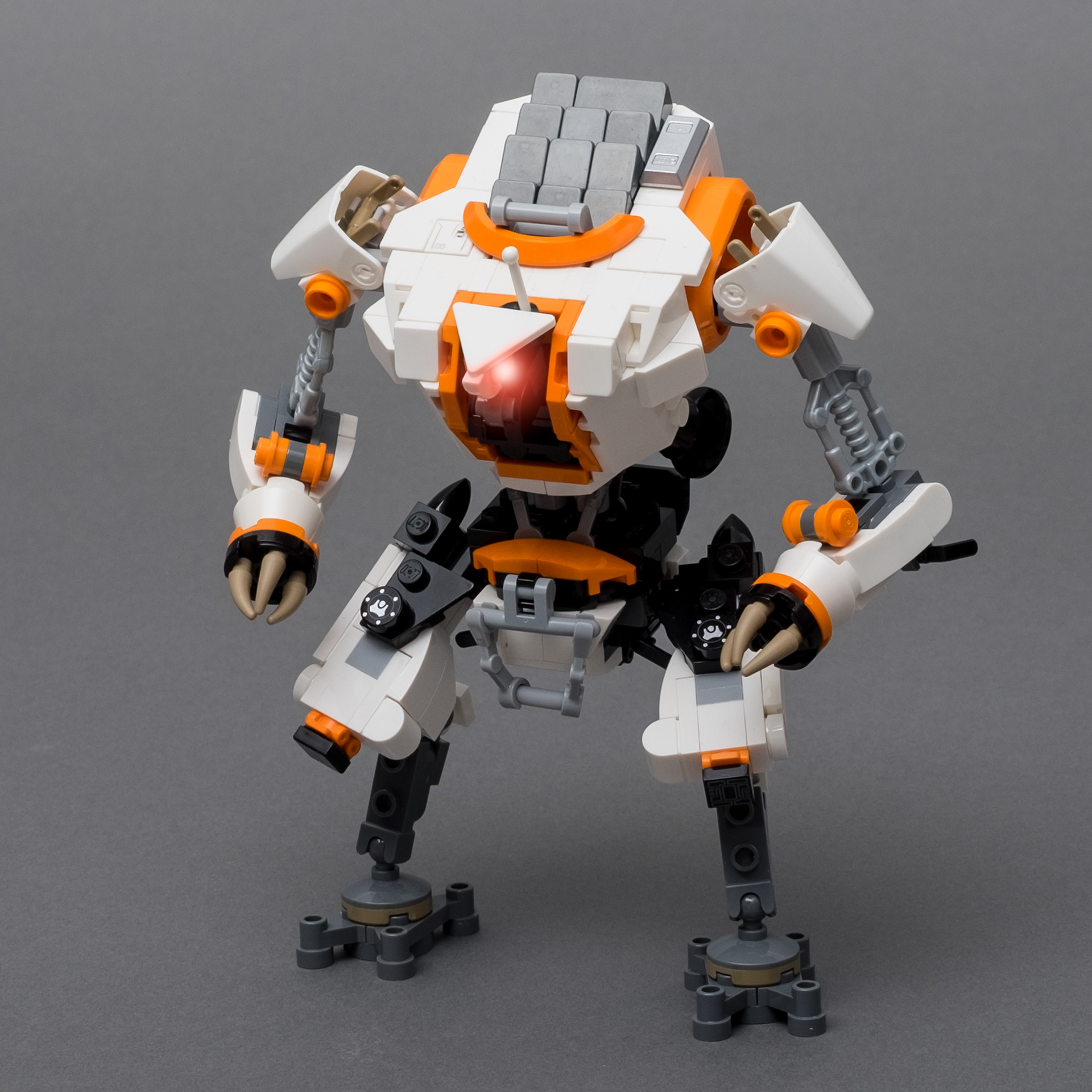Like the Atlas from the first Titanfall, Ion could be considered the titular multiplayer Titan of the second game. Developed by Respawn Entertainment LLC and published by EA in 2016, Titanfall 2 expands the Titanfall universe by introducing a plethora of new Titans, vehicles, locations and enemies. And while Ion is clearly based on the Atlas Titan-frame in terms of proportions and layout, it features a new, much more angular and clean design. It is a medium Titan-frame, meaning it is more heavily armoured than Ronin, for example, but still offers decent manoeuvrability. In the first Titanfall, the Titans were solely distinct by their size and weight but in Titanfall 2 the six newly introduced Titans each have a unique theme surrounding their weapons, abilities and design. Ion's theme is laser-based attacks. It is equipped with a Splinter Rifle, an energy weapon powered by Ion's main energy supply, and its ordnance ability is a laser shot fired from a small shoulder-mounted rifle. Ion's most destructive ability is the activation of the Laser Core which shoots an enormous beam from the central blue eye of the cockpit. This is the reason why this section of the head is much more pronounced than on the other Titan designs. The triangular shape points forward and towards the eye, while multiple cables connect it to the power supply at the back.
Customising the look of the Titan is a big part of the multiplayer experience of Titanfall 2. Therefore many different colour-schemes and patterns are available. For the LEGO® model I chose the base version, which for Ion is dark-bluish grey (Colour-ID 85) with bright light orange (Colour-ID 110) accents. One interesting aspect of the colour scheme is that Ion's backside is much brighter than its front, it was therefore mainly replicated with light-bluish grey (Colour-ID 86) LEGO® pieces.
"Laser Core ready!"
- Titan OS
A unique design element of the Ion Titan-class is the inclusion of three additional sensors that complement the central 'eye'; one on each shoulder and one on top of the cockpit. They are shaped like small black spheres with a central blue light. I chose to use LEGO® ball joints (Part-ID 32474) since they mimic the shape of these sensors the best. The cables, connecting the central 'eye' to the power sources at the side of the cockpit were recreated with LEGO® strings.
Because Ion is a medium size Titan-class I could use larger and sturdier LEGO® hinges. The connection between the feet and the legs, the knee joint, the connection to the hip as well as the shoulders were all created using LEGO® Technic rotation joint (Part-ID 48169, 48170 and 48172). The tilt forward at the shin, however, was achieved with hinge plates (Part-ID 2429 and 2430). Although these would normally not be strong enough to hold up the figure, the surrounding area is build in a way that essentially holds the leg in place at the right angle. Ion therefore does not need additional support.
The realism and grittiness within the futuristic design of the Titans is what immediately drew me to the Titanfall art style. Each panel is littered with vents, cables, antennas or logos which makes them a lot of fun to design. My favourite detail is that some of the Titans, like Ion, carry ammo pouches and small cloth bags around their cockpit or legs. Them having to carry their utilities in bags, like humans, gives them so much character in my opinion. I therefore fought it only fitting to use actual LEGO® Minifigure backpacks (Part-ID 2524) to replicate them. Using these LEGO® parts in the old dark grey (Colour-ID 10) also gives them a nice contrast from the dark-bluish grey colour of the Titan.
Ion's robust frame allowed it to also hold its iconic weapon from the game: The Splitter Rifle. It is a particle accelerator with a large circular magazine. I wanted to stay faithful to the representation in-game and therefore used the LEGO® colour medium nougat (Colour-ID 150) for most of the rifle. That particular colour is white limited in the range of bricks available so the design is a bit more blocky than the source material. But the 4*4 circle plate (Part-ID 11833) at the center is tough to give the weapon its recognisable shape. Additionally, a 2*2 round tile with a rotor blade pattern print (Part-ID 15535pb01) gives some additional detail.
There are bright light orange (Colour-ID 110) accents throughout the design of the Titan. On the cockpit, the shoulders, the forearms and the rear, these were made with actual LEGO®. On the right knee as well as on the heels the accents were created using custom decals. Meanwhile, the black stripe on the cockpit is completely brick build.


Assault on Forward Base Kodai
When deciding on a diorama to build for Ion, I wanted to avoid colours already used for the Titan model. The multiplayer map "Forward Base Kodai", with its desert-like environment and its dark red (Colour-ID 59) leafed trees was the perfect fit. All the structures on the original map an extremely large and would have dwarfed the Titan model. Therefore I decided to solely use the tree design and foliage for the diorama. I also used multiple 2*2*2 quadruple convex pieces (Part-ID 3688) in light grey (Colour-ID 9) to recreate the anti-tank obstacles which can be found on the original map.
Reaper
The introduction of a single-player-campaign in Titanfall 2 inspired the development of new threats and enemies. Since the player is often switching between piloting a Titan and on-foot combat, creating an enemy that would be challenging for both scenarios is particularly interesting. The Reaper fills that role. Having been called "Super Spectre" during development, it is a lot bigger than the humanoid Spectre enemies and roughly half the size of a Titan.
When fighting them on foot, Reapers almost act like mini-bosses. Their bulky shoulders and brute-like design underline this impression. To avoid their barrage of rockets and melee attacks the player must move quickly in-and-out of cover and outmanoeuvre the Reapers. But when the player himself is in a Titan, these roles are reversed. Now the Reaper is the more agile fighter and the player must take him out quickly to avoid being outrun.
It is that functionality, which gives the Titanfall 2 campaign the necessary variety. And the addition of a Reaper to the LEGO® dioramas helps to display said variety.
For building the Reaper with LEGO® to make sense, it had to be in the same scale as the Titans. This demanded some creative solutions to maintain both the form of the original as well as the livery. The colour splits of white (Colour-ID 1) and orange (4) are primarily achieved by using LEGO® wheel arches (Part-ID 28326) on the side and top of the torso. A white road sign (Part-ID 892) is used for the shape of the head and old head-pieces (Part-ID x209) from the LEGO® "Slizer" product line are used for the shoulders. Minifigure weapons (Part-ID 55237g) compose his upper arms and the addition of multiple bucket-handles add the necessary texture.



"Stand by for Titanfall"
You can buy the instructions to build your own Ion and Reaper here:
Render of the finished model
Render of the finished model